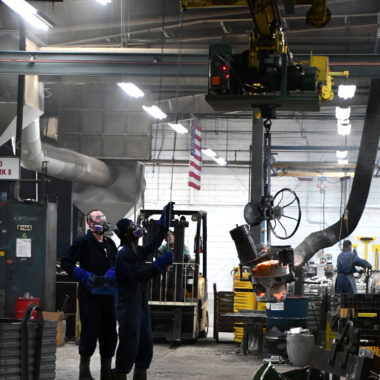Grasping About Aluminum Casting: Techniques Debunked
Grasping About Aluminum Casting: Techniques Debunked
Blog Article
From Design to Complete: The Full Aluminum Casting Process Demystified
In the realm of manufacturing, the process of light weight aluminum spreading stands as an essential technique that has fueled sectors for years. Remain tuned as we explore the complete aluminum spreading process, uncovering the intricacies that transform raw materials right into polished products.
Creating the Casting Mold And Mildew
When starting the aluminum spreading process, precise attention to designing the spreading mold is paramount for guaranteeing the final item's stability and top quality. The spreading mold acts as the foundation for the entire spreading process, determining the form, dimensions, and surface area finish of the ultimate aluminum component.
To develop an effective spreading mold, engineers have to think about numerous aspects such as the complexity of the component, the type of light weight aluminum alloy being made use of, and the preferred residential properties of the end product. about aluminum casting. Computer-aided layout (CAD) software program is often utilized to create in-depth schematics of the mold, enabling exact customization and optimization
In addition, the style of the spreading mold straight impacts the effectiveness and cost-effectiveness of the spreading process. A properly designed mold and mildew reduces product waste, reduces the requirement for considerable post-casting machining, and enhances general manufacturing speed.
Melting and Putting Light Weight Aluminum
With the design of the casting mold completed, the next important action in the light weight aluminum spreading procedure is the melting and putting of the light weight aluminum alloy. When the light weight aluminum is molten, it is important to preserve the temperature within a particular variety to guarantee the high quality of the castings.
The molten light weight aluminum is very carefully transferred from the heater to the spreading mold. Correct pouring techniques add substantially to the overall top quality of the final aluminum casting.
Cooling and strengthening Process
Upon completion of the putting process, the liquified aluminum changes into the cooling and strengthening stage, a vital phase in the light weight aluminum spreading procedure that straight impacts the final product's stability and qualities. As the light weight aluminum starts to cool, its molecules organize themselves right into a strong kind, gradually taking on the shape of the mold.
During this phase, it is necessary to regulate the cooling process thoroughly to prevent problems such as porosity, shrinking, or interior tensions. Different cooling methods, such as air cooling, water quenching, or controlled air conditioning chambers, can be used based upon the certain demands of the casting (about aluminum casting). By keeping an eye on and controling the solidification and cooling down procedure, producers can ensure the manufacturing of high-grade light weight aluminum spreadings with the preferred mechanical and metallurgical properties

Eliminating the Last Spreading
Once the light weight aluminum spreading has completely strengthened and cooled in the mold, the next action in the process includes carefully eliminating the last spreading. browse around this site This action is essential to make sure that the light weight aluminum component is successfully extracted without any type of damages or issues.
To remove the casting, the mold is opened, and the casting is drawn out utilizing different approaches relying on the intricacy of the component and the mold and mildew layout. For less complex forms, the spreading can often be easily removed by hand or with straightforward tools. However, for more intricate designs, additional equipment such as ejector pins, air blasts, or hydraulic systems might be called for to facilitate the removal procedure without creating any kind of injury to the spreading.
After the spreading is effectively eliminated from the mold, any excess product such as entrances, runners, or risers that were used throughout the spreading process are trimmed off. This action aids in accomplishing the final preferred form of the aluminum component before it undertakes any kind of added ending up processes.
Finishing and Quality Inspection
The last in the light weight aluminum spreading process involves precise click for info finishing techniques and strenuous high quality inspection methods to make sure the integrity and accuracy of the cast light weight aluminum components. Finishing methods such as grinding, sanding, and shot blasting are made use of to eliminate any excess product, smooth rough surface areas, and enhance the visual appeal of the end product. These procedures not just here are the findings improve the look but additionally guarantee that the components meet the specified dimensional resistances and surface coating demands.

Final Thought
Finally, the light weight aluminum casting procedure entails creating the mold, melting and putting light weight aluminum, cooling the spreading and solidifying, removing the end product, and do with a top quality assessment. Each step is critical in making sure the end product satisfies the desired requirements. By comprehending the whole process, suppliers can create top quality light weight aluminum castings successfully and efficiently.
Stay tuned as we study the complete light weight aluminum casting process, revealing the complexities that change raw materials right into refined items.
With the design of the casting mold and mildew completed, the following critical step in the light weight aluminum casting process is the melting and putting of the aluminum alloy.Upon completion of the putting procedure, the molten aluminum shifts right into the cooling and strengthening stage, a vital phase in the aluminum spreading process that directly affects the last item's integrity and attributes.The last phase in the aluminum casting process includes thorough finishing techniques and extensive high quality examination methods to ensure the stability and accuracy of the actors light weight aluminum components.In verdict, the light weight aluminum spreading process includes designing the mold and mildew, melting and pouring aluminum, solidifying and cooling the casting, eliminating the last item, and ending up with a top quality examination.
Report this page